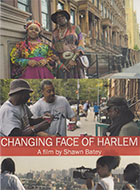
Changing Face of Harlem 2013
Distributed by Third World Newsreel, 545 Eighth Avenue, Suite 550, New York, NY 10018; 212-947-9277
Produced by Shawn Batey and Shaun Jaffier
Directed by Shawn Batey
DVD, color, 62 min.
College - General Adult
Urban Renewal, Urban Development, Economics, New York, History, African Americans
Date Entered: 11/16/2016
Reviewed by Sharadha Natraj, University of Wisconsin Milwaukee, School of Architecture and Urban PlanningThe history of Harlem is laced with politics, economic disparity and racial dynamics. In Changing Face of Harlem, Shawn Batey takes a sober look at these factors as they make an impact on the community through time, tracing change from a vibrant and economically flourishing community which was the home of figures such as Langston Hughes and Zora Neale Hurston and a center of Black culture, to the “ghettoization” of the area and its decline into an area taken over by drugs and economic depression.
Through personal stories of long-term residents and children who have grown and returned to their beloved home, and snippets of footage showing life in Harlem over the years, this film weaves stories of Harlem history and the changes that have occurred since its heyday. Over the course of ten years, the film pays visits to Frank, a building superintendent; Asadah, an entrepreneur; and Tekima, a hat vendor in Harlem’s Mart 125; as they recount their memories, hopes and struggles against a backdrop of the events that shaped their community over the years.
In the late 1990s, national retail chains began coming into Harlem, followed by developers taking over properties and erecting market-rate housing that replaced affordable housing, attracting a diverse clientele from around the region and displacing lower-income black residents and shop owners. The struggle that comes with urban revitalization is clearly depicted, bringing up a conflicted reaction to the value of gentrification.
That urban areas are rescued from depression and neglect is surely a good thing? Surely, diversity is ideal? Or does gentrification allow developers and corporations to take advantage of low prices to snap up properties and displace powerless residents, simply for economic profit? Batey highlights each issue that such development brings, presenting the positives and negatives in a manner that invites questioning and debate. The dynamics of local communities within a larger economic and political climate are effectively conveyed, as is the resilience of long-time Harlem residents, who fight for their right to affordable housing and the right to maintain their homes and businesses.
Changing Face of Harlem brings up issues of economy, business, politics, race and society. It makes the viewer reflect on possibilities that could enhance the lives of longtime residents and maintain local identity while inviting diversity and development.
This film is highly recommended.